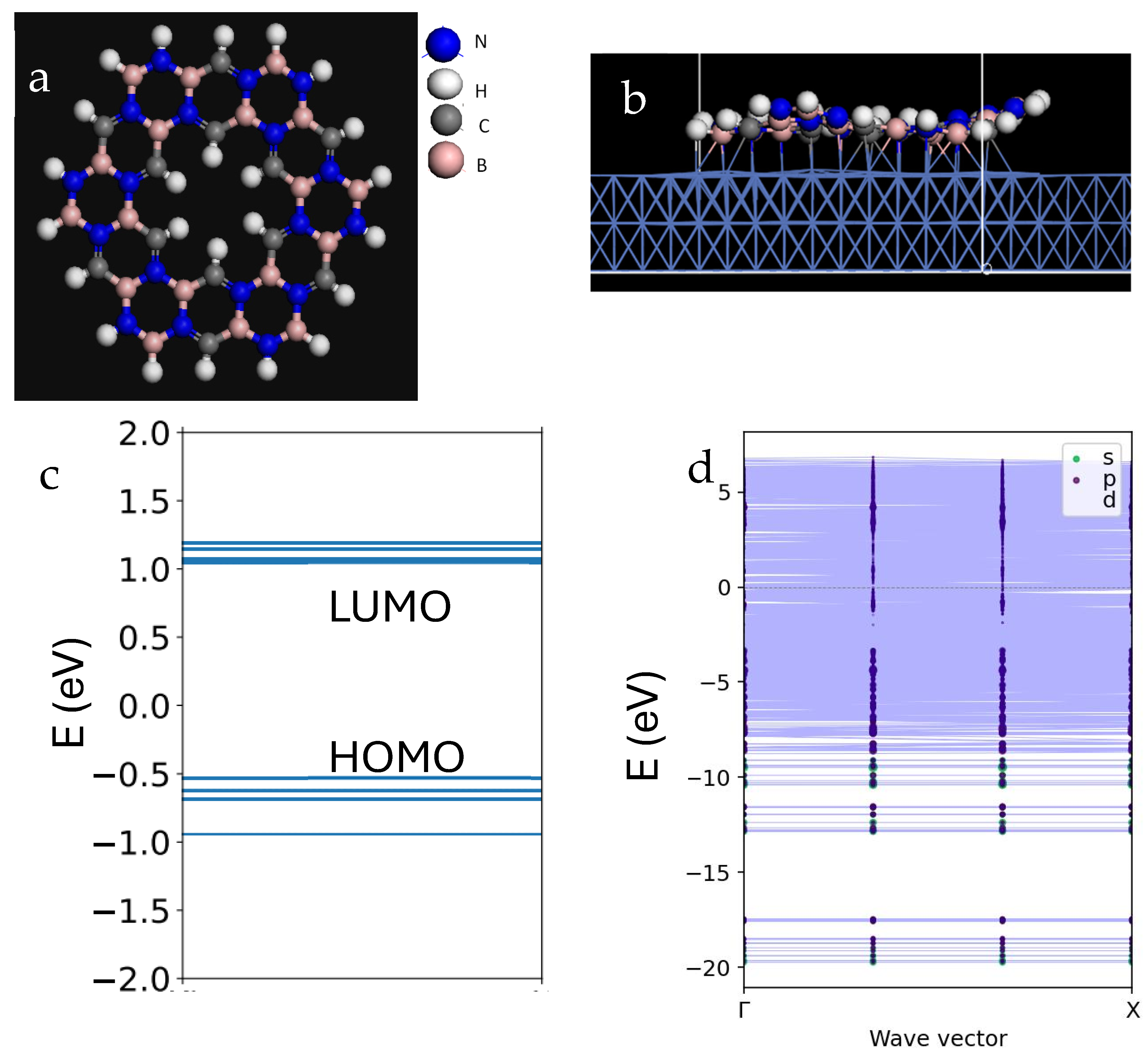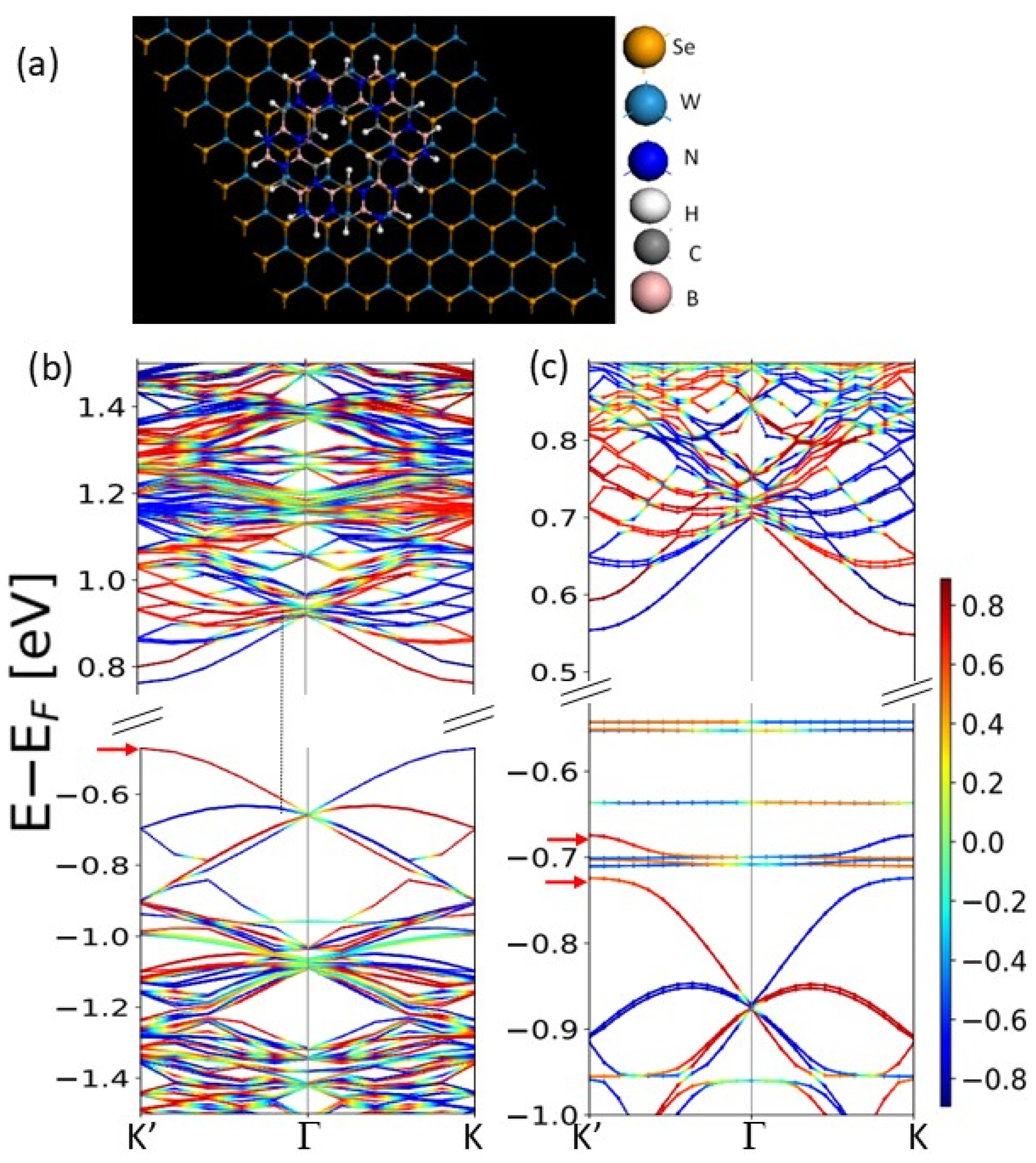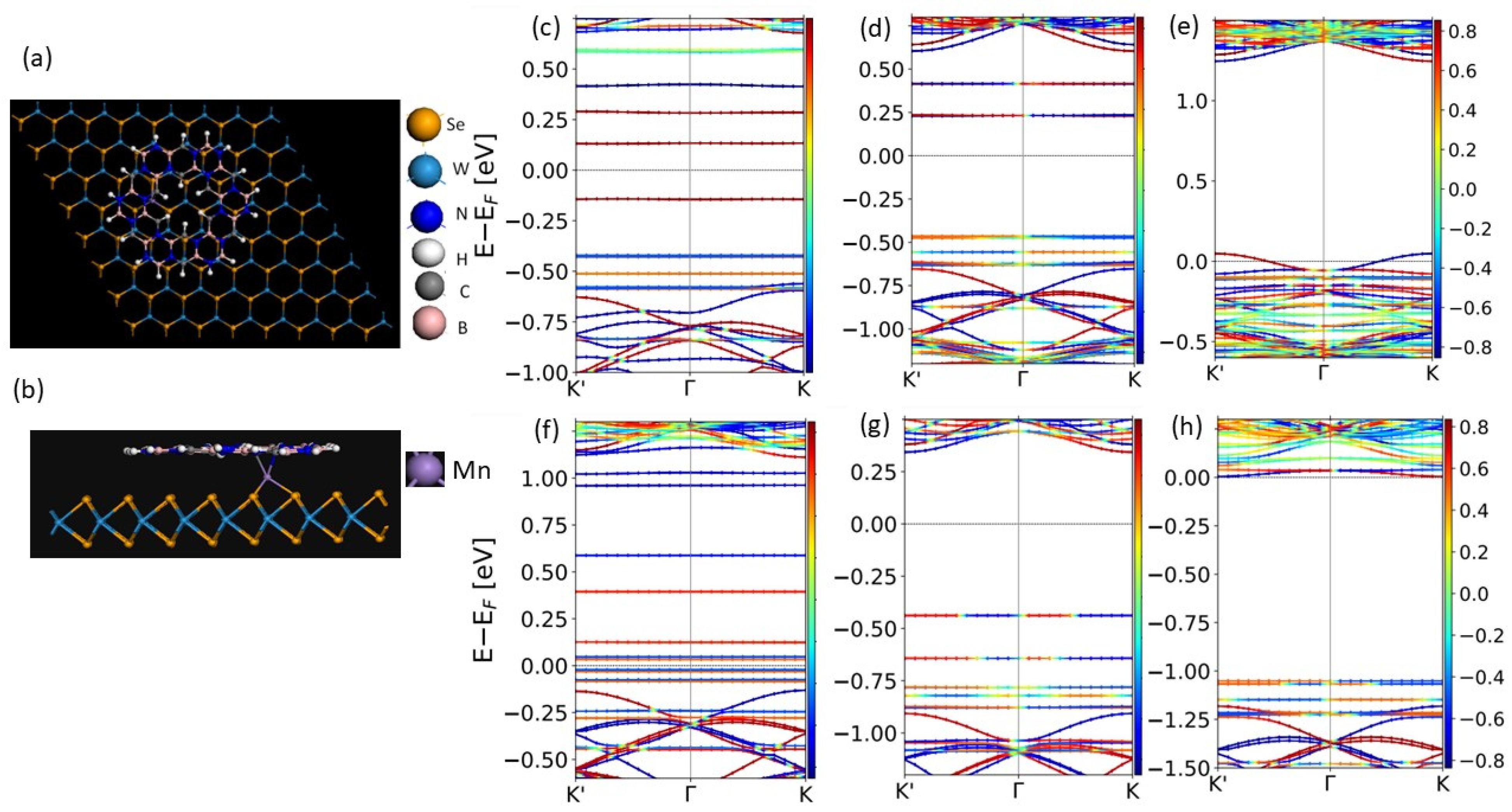Proximity Effect of Optically Active h-BCN Nanoflakes Deposited on Different Substrates to Tailor Electronic, Spintronic, and Optoelectronic Properties
Abstract
1. Introduction
2. Methodology
3. Results and Discussion
3.1. Properties of h-BCN Molecule on Metallic Substrate
3.2. Proximity Effect in h-BCN/WSe2 Bi-Layer
3.3. Interfacial Effect in h-BCN Deposited on Defect-Modified WSe2 Monolayer
4. Conclusions
Supplementary Materials
Author Contributions
Funding
Institutional Review Board Statement
Informed Consent Statement
Data Availability Statement
Conflicts of Interest
References
- Wu, Y.; Wang, Y.; Bao, D.; Deng, X.; Zhang, S.; Yu-Chun, L.; Ke, S.; Liu, J.; Liu, Y.; Wang, Z. Emerging probing perspective of two-dimensional materials physics: Terahertz emission spectroscopy. Light Sci. Appl. 2024, 13, 146. [Google Scholar] [CrossRef] [PubMed]
- Wu, Y.; Liu, Y.; Li, Y.; Wei, Z.; Xing, S.; Wang, Y.; Zhu, D.; Guo, Z.; Zhang, A.; Yuan, G. Symmetry engineering in 2D bioelectronics facilitating augmented biosensing interfaces. Proc. Natl. Acad. Sci. USA 2024, 121, e2412684121. [Google Scholar] [CrossRef]
- Ji, H.; Liu, Y.; Ji, C.; Wang, J. Two-Dimensional and Interface Superconductivity in Crystalline Systems. Acc. Mater. Res. 2024, 5, 1146–1157. [Google Scholar] [CrossRef]
- Zhai, X.; Blanter, Y.M. Proximity-induced diversified magnetic states and electrically controllable spin polarization in bilayer graphene: Towards layered spintronics. Phys. Rev. B 2022, 106, 075425. [Google Scholar] [CrossRef]
- Fu, Z.; Samarawickrama, P.I.; Ackerman, J.; Zhu, Y.; Mao, Z.; Watanabe, K.; Taniguchi, T.; Wang, W.; Dahnovsky, Y.; Wu, M. Tunneling current-controlled spin states in few-layer van der Waals magnets. Nat. Commun. 2024, 15, 3630. [Google Scholar] [CrossRef]
- Klein, J.; Pham, T.; Thomsen, J.; Curtis, J.; Denneulin, T.; Lorke, M.; Florian, M.; Steinhoff, A.; Wiscons, R.; Luxa, J. Control of structure and spin texture in the van der Waals layered magnet CrSBr. Nat. Commun. 2022, 13, 5420. [Google Scholar] [CrossRef]
- Guo, Y.; Zhang, X.; Huang, Z.; Chen, J.; Luo, Z.; Zhang, J.; Li, J.; Zhang, Z.; Zhao, J.; Han, X. Quantum materials for spintronic applications. npj Spintronics 2024, 2, 36. [Google Scholar] [CrossRef]
- Bloom, B.P.; Paltiel, Y.; Naaman, R.; Waldeck, D.H. Chiral induced spin selectivity. Chem. Rev. 2024, 124, 1950–1991. [Google Scholar] [CrossRef]
- Naaman, R.; Waldeck, D.H. Chiral-induced spin selectivity effect. J. Phys. Chem. Lett. 2012, 3, 2178–2187. [Google Scholar] [CrossRef]
- Kim, Y.-H.; Zhai, Y.; Lu, H.; Pan, X.; Xiao, C.; Gaulding, E.A.; Harvey, S.P.; Berry, J.J.; Vardeny, Z.V.; Luther, J.M. Chiral-induced spin selectivity enables a room-temperature spin light-emitting diode. Science 2021, 371, 1129–1133. [Google Scholar] [CrossRef]
- Lin, L.; Lu, J.; Ying, L.; Weinan, E. Optimized local basis set for Kohn–Sham density functional theory. J. Comput. Phys. 2012, 231, 4515–4529. [Google Scholar] [CrossRef]
- Huisman, K.H.; Thijssen, J.M. CISS effect: A magnetoresistance through inelastic scattering. J. Phys. Chem. C 2021, 125, 23364–23369. [Google Scholar] [CrossRef] [PubMed]
- Zhao, Y.; Zhang, K.; Xiao, J.; Sun, K.; Yan, B. Magnetochiral charge pumping due to charge trapping and skin effect in chirality-induced spin selectivity. Nat. Commun. 2025, 16, 37. [Google Scholar] [CrossRef] [PubMed]
- Varela, S.; Gutierrez, R.; Cuniberti, G.; Medina, E.; Mujica, V. Chiral spin selectivity and chiroptical activity in helical molecules. J. Chem. Phys. 2024, 161, 114111. [Google Scholar] [CrossRef]
- Lu, H.; Wang, J.; Xiao, C.; Pan, X.; Chen, X.; Brunecky, R.; Berry, J.J.; Zhu, K.; Beard, M.C.; Vardeny, Z.V. Spin-dependent charge transport through 2D chiral hybrid lead-iodide perovskites. Sci. Adv. 2019, 5, eaay0571. [Google Scholar] [CrossRef]
- Ben Dor, O.; Yochelis, S.; Radko, A.; Vankayala, K.; Capua, E.; Capua, A.; Yang, S.-H.; Baczewski, L.T.; Parkin, S.S.P.; Naaman, R. Magnetization switching in ferromagnets by adsorbed chiral molecules without current or external magnetic field. Nat. Commun. 2017, 8, 14567. [Google Scholar] [CrossRef]
- Burkard, G.; Ladd, T.D.; Pan, A.; Nichol, J.M.; Petta, J.R. Semiconductor spin qubits. Rev. Mod. Phys. 2023, 95, 025003. [Google Scholar] [CrossRef]
- Chatterjee, A.; Stevenson, P.; De Franceschi, S.; Morello, A.; de Leon, N.P.; Kuemmeth, F. Semiconductor qubits in practice. Nat. Rev. Phys. 2021, 3, 157–177. [Google Scholar] [CrossRef]
- Heindel, T.; Kim, J.-H.; Gregersen, N.; Rastelli, A.; Reitzenstein, S. Quantum dots for photonic quantum information technology. Adv. Opt. Photonics 2023, 15, 613–738. [Google Scholar] [CrossRef]
- Beniwal, S.; Hooper, J.; Miller, D.P.; Costa, P.S.; Chen, G.; Liu, S.-Y.; Dowben, P.A.; Sykes, E.C.H.; Zurek, E.; Enders, A. Graphene-like boron–carbon–nitrogen monolayers. ACS Nano 2017, 11, 2486–2493. [Google Scholar] [CrossRef]
- Cheng, L.; Meng, J.; Pan, X.; Lu, Y.; Zhang, X.; Gao, M.; Yin, Z.; Wang, D.; Wang, Y.; You, J. Two-dimensional hexagonal boron–carbon–nitrogen atomic layers. Nanoscale 2019, 11, 10454–10462. [Google Scholar] [CrossRef] [PubMed]
- dos Santos, R.M.; Giozza, W.F.; de Sousa Júnior, R.T.; da Silva Filho, D.A.; Júnior, L.A.R. On the electronic structure of a recently synthesized graphene-like BCN monolayer from bis-BN cyclohexane with single-atom vacancies: A DFT study. Electron. Struct. 2021, 3, 014006. [Google Scholar] [CrossRef]
- Legrand, W.; Chauleau, J.-Y.; Maccariello, D.; Reyren, N.; Collin, S.; Bouzehouane, K.; Jaouen, N.; Cros, V.; Fert, A. Hybrid chiral domain walls and skyrmions in magnetic multilayers. Sci. Adv. 2018, 4, eaat0415. [Google Scholar] [CrossRef]
- Nakagahara, K.; Wakabayashi, K. Enhanced valley polarization of graphene on h-BN under circularly polarized light irradiation. Phys. Rev. B 2022, 106, 075403. [Google Scholar] [CrossRef]
- Chien, S.-P.; Chang, Y.-C.; Simbulan, K.B.; Saha, S.; Chiang, Y.-F.; Saroj, R.K.; Yi, G.-C.; Arafin, S.; Lu, T.-H.; Lan, Y.-W. Helicity exchange and symmetry breaking of in-plane phonon scattering of h-BN probed by polarized Raman spectroscopy. Appl. Phys. Lett. 2022, 121, 182203. [Google Scholar] [CrossRef]
- Smabraten, D.R.; Nylund, I.-E.; Marshall, K.; Walker, J.; Benelmekki, M.; Einarsrud, M.-A.; Kioseoglou, J.; Selbach, S.M. Electronic Structure and Surface Chemistry of Hexagonal Boron Nitride on HOPG and Nickel Substrates. ACS Omega 2023, 8, 24813–24830. [Google Scholar] [CrossRef]
- Wang, J.; Ma, F.; Liang, W.; Wang, R.; Sun, M. Optical, photonic and optoelectronic properties of graphene, h-BN and their hybrid materials. Nanophotonics 2017, 6, 943–976. [Google Scholar] [CrossRef]
- Simeonov, S.P.; Nunes, J.P.; Guerra, K.; Kurteva, V.B.; Afonso, C.A. Synthesis of chiral cyclopentenones. Chem. Rev. 2016, 116, 5744–5893. [Google Scholar] [CrossRef]
- Brown, H.C.; Singaram, B. The development of a simple general procedure for synthesis of pure enantiomers via chiral organoboranes. Acc. Chem. Res. 1988, 21, 287–293. [Google Scholar] [CrossRef]
- Nechayev, S.; Barczyk, R.; Mick, U.; Banzer, P. Substrate-induced chirality in an individual nanostructure. ACS Photonics 2019, 6, 1876–1881. [Google Scholar] [CrossRef]
- Lu, Z.; Yu, D.; Hong, Y.; Ma, G.; Ru, F.; Ge, T.; Xi, G.; Qin, L.; Adilov, M.; Ashurov, R.; et al. Recent advances and future perspectives of bismuthene: From preparation to applications. Mater. Today 2024, 80, 565–593. [Google Scholar] [CrossRef]
- Luo, W.; Ru, F.; Yu, D.; Liu, H.; Gao, W.; Song, W.; Chen, D. Two-dimensional monoelement nanosheets produced from bulk crystals for potassium-ion storage. Chem. Phys. Lett. 2023, 830, 140824. [Google Scholar] [CrossRef]
- Grimme, S.; Antony, J.; Ehrlich, S.; Krieg, H. A consistent and accurate ab initio parametrization of density functional dispersion correction (DFT-D) for the 94 elements H-Pu. J. Chem. Phys. 2010, 132, 1456. [Google Scholar] [CrossRef] [PubMed]
- Kuang, G.; Murugan, N.A.; Ågren, H. Mechanistic insight into the binding profile of DCVJ and α-synuclein fibril revealed by multiscale simulations. ACS Chem. Neurosci. 2018, 10, 610–617. [Google Scholar] [CrossRef]
- Grimme, S.; Ehrlich, S.; Goerigk, L. Effect of the damping function in dispersion corrected density functional theory. J. Comput. Chem. 2011, 32, 1456–1465. [Google Scholar] [CrossRef]
- Xie, W.-Q.; He, C.-C.; Yang, X.-B.; Zhao, Y.-J.; Geng, W.-T. Strain-Induced Interlayer Magnetic Coupling Spike of the Two-Dimensional van der Waals Material Fe5GeTe2. J. Phys. Chem. C 2023, 127, 17194–17200. [Google Scholar] [CrossRef]
- He, X.; Helbig, N.; Verstraete, M.J.; Bousquet, E. TB2J: A python package for computing magnetic interaction parameters. Comput. Phys. Commun. 2021, 264, 107938. [Google Scholar] [CrossRef]
- Majidi, R. Exploring two-dimensional metal bis (dithiolene) sheets for optoelectronic applications: A density functional theory study. Mater. Sci. Eng. B 2025, 313, 117929. [Google Scholar] [CrossRef]
- Ozaki, T.; Kino, H. Numerical atomic basis orbitals from H to Kr. Phys. Rev. B 2004, 69, 195113. [Google Scholar] [CrossRef]
- Mostofi, A.A.; Yates, J.R.; Pizzi, G.; Lee, Y.-S.; Souza, I.; Vanderbilt, D.; Marzari, N. An updated version of wannier90: A tool for obtaining maximally-localised Wannier functions. Comput. Phys. Commun. 2014, 185, 2309–2310. [Google Scholar] [CrossRef]
- Yue, X.; Yang, J.; Li, W.; Jing, Y.; Dong, L.; Zhang, Y.; Li, X. Electron irradiation induces the conversion from 2H-WSe2 to 1T-WSe2 and promotes the performance of electrocatalytic hydrogen evolution. ACS Sustain. Chem. Eng. 2022, 10, 2420–2428. [Google Scholar] [CrossRef]
- Leiter, R.; Li, Y.; Kaiser, U. In-situ formation and evolution of atomic defects in monolayer WSe2 under electron irradiation. Nanotechnology 2020, 31, 495704. [Google Scholar] [CrossRef] [PubMed]



| Substrate (10 × 10xnL) | Ir (2 L) | Ir (3 L) | Ni (2 L) | Ni (3 L) | Cu (2 L) | Cu (3 L) |
| Adsorption energy, eV | −6.58 | −9.33 | −9.05 | −11.36 | −0.88 | −0.73 |
| Mn | Co | Ni | |
|---|---|---|---|
| N-TM | 2.03 | 2.112 | 2.112 |
| C-TM | 2.11 | 2.125 | 2.125 |
| Se-TM | 2.49, 2.46 | 2.44, 2.32 | 2.35 |
Disclaimer/Publisher’s Note: The statements, opinions and data contained in all publications are solely those of the individual author(s) and contributor(s) and not of MDPI and/or the editor(s). MDPI and/or the editor(s) disclaim responsibility for any injury to people or property resulting from any ideas, methods, instructions or products referred to in the content. |
© 2025 by the authors. Licensee MDPI, Basel, Switzerland. This article is an open access article distributed under the terms and conditions of the Creative Commons Attribution (CC BY) license (https://creativecommons.org/licenses/by/4.0/).
Share and Cite
Alsaad, A.; Bai, J.; Mei, W.-N.; Turallo, J.; Ilie, C.; Sabirianov, R. Proximity Effect of Optically Active h-BCN Nanoflakes Deposited on Different Substrates to Tailor Electronic, Spintronic, and Optoelectronic Properties. Int. J. Mol. Sci. 2025, 26, 2096. https://doi.org/10.3390/ijms26052096
Alsaad A, Bai J, Mei W-N, Turallo J, Ilie C, Sabirianov R. Proximity Effect of Optically Active h-BCN Nanoflakes Deposited on Different Substrates to Tailor Electronic, Spintronic, and Optoelectronic Properties. International Journal of Molecular Sciences. 2025; 26(5):2096. https://doi.org/10.3390/ijms26052096
Chicago/Turabian StyleAlsaad, Ahmad, Jaeil Bai, Wai-Ning Mei, Joel Turallo, Carolina Ilie, and Renat Sabirianov. 2025. "Proximity Effect of Optically Active h-BCN Nanoflakes Deposited on Different Substrates to Tailor Electronic, Spintronic, and Optoelectronic Properties" International Journal of Molecular Sciences 26, no. 5: 2096. https://doi.org/10.3390/ijms26052096
APA StyleAlsaad, A., Bai, J., Mei, W.-N., Turallo, J., Ilie, C., & Sabirianov, R. (2025). Proximity Effect of Optically Active h-BCN Nanoflakes Deposited on Different Substrates to Tailor Electronic, Spintronic, and Optoelectronic Properties. International Journal of Molecular Sciences, 26(5), 2096. https://doi.org/10.3390/ijms26052096






